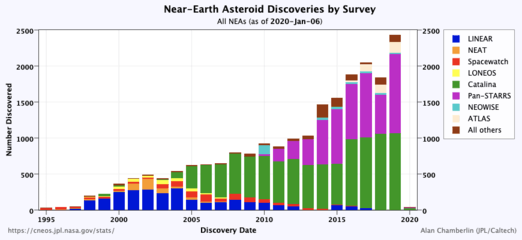Lincoln Near-Earth Asteroid Research
The Lincoln Near-Earth Asteroid Research (LINEAR) project is a collaboration of the United States Air Force, NASA, and the MIT's Lincoln Laboratory for the systematic detection and tracking of near-Earth objects. LINEAR was responsible for the majority of asteroid discoveries from 1998 until it was overtaken by the Catalina Sky Survey in 2005.[1] As of 15 September 2011, LINEAR had detected 231,082 new small Solar System bodies, of which at least 2,423 were near-Earth asteroids and 279 were comets.[2] The instruments used by the LINEAR program are located at Lincoln Laboratory's Experimental Test Site (ETS) on the White Sands Missile Range (WSMR) near Socorro, New Mexico.
| Alternative names | LINEAR |
|---|---|
| Survey type | astronomical survey |
| Target | near-Earth object |
| Coordinates | 33°49′05″N 106°39′33″W |
| Named after | MIT Lincoln Laboratory |
| Observatory code | 704 |
| Website | www |

|
LINEAR NEAT Spacewatch LONEOS |
CSS Pan-STARRS NEOWISE All others |
History
In the late 1970s, the Lincoln Laboratory's Experimental Test Site facility (observatory code 704) was built at White Sands Missile Range.[3][4] The project's prototype used low-light video cameras.[5] In 1994 a new proposal was made for automated detection of asteroids, this time using newer digital detector technology.[6] The LINEAR project began operating a near-Earth object discovery facility in 1996 using a 1.0 m (39 in) aperture telescope designed for the Air Force Space Command's Ground-based Electro-Optical Deep Space Surveillance (GEODSS). The wide-field Air Force telescopes were designed for optical observation of Earth-orbiting spacecraft. Initial field tests used a 1024 × 1024 pixel charge-coupled device (CCD) detector. While this CCD detector filled only about one fifth of the telescope's field of view, four near-earth objects were discovered. A 1960 × 2560 pixel CCD which covered the telescope's two-square degree field of view was then installed, and both detectors were used in later tests.[7]
The first LINEAR telescope became fully operational in March 1998.[8] Beginning in October 1999, a second 1.0 m telescope was added to the search effort.[9] In 2002, a 0.5 m (20 in) telescope equipped with the original CCD was brought on-line to provide follow-up observations for the discoveries made by the two search telescopes.[10] This allowed about 20% more of the sky to be searched each night. Data recorded by the telescopes is sent to a Lincoln Laboratory facility at Hanscom Air Force Base in Lexington, Massachusetts for processing. Detections are then forwarded to the Minor Planet Center.[2]
Discoveries
| see List of minor planets § Main index |
In addition to discovering more than 140,000 minor planets, LINEAR is also credited with the discovery, or co-discovery, or rediscovery of several periodic comets, including 11P/Tempel–Swift–LINEAR, 158P/Kowal-LINEAR, 160P/LINEAR (LINEAR 43), 165P/LINEAR (LINEAR 10), and 176P/LINEAR (LINEAR 52, 118401 LINEAR: one of only five objects classified both as comets and asteroids). Other objects discovered include (137108) 1999 AN10, (179806) 2002 TD66, and 2004 FH.
See also
References
- "NEO Discovery Statistics". NASA Near Earth Object Program. Retrieved 2012-01-19.
- "MIT Lincoln Laboratory: LINEAR". MIT Lincoln Laboratory. Archived from the original on 2017-07-24. Retrieved 2012-01-19.
- Beatty, D. E.; Sorvari, J. M.; Taff, L. G. (1980). "Artificial satellites, minor planets, and the ETS". Unknown. 81: 12143. Bibcode:1980STIN...8112143B.
- "LINEAR – Experimental Test Site". Lincoln Laboratory, MIT. Archived from the original on 26 June 2017. Retrieved 3 November 2016.
- Taff, L. G. (1981). "A new asteroid observation and search technique". Publications of the Astronomical Society of the Pacific. 93: 658. Bibcode:1981PASP...93..658T. doi:10.1086/130905.
- Tennyson, Peter D.; Rork, Eugene W.; Kostishack, Daniel F. (1994). "Applying electro-optical space surveillance technology to the detection of near-Earth asteroids". Proceedings of SPIE. Instrumentation in Astronomy VIII. 2198: 1286. doi:10.1117/12.176813.
- "Lincoln Near-Earth Asteroid Research (LINEAR)". NASA Near Earth Object Program. Retrieved 2012-01-19.
- Stokes, G. H.; Viggh, H. E. M.; Shelly, F. L.; Blythe, M. S.; Stuart, J. S. (1998). "Results from the Lincoln Near Earth Asteroid Research (LINEAR) Project". American Astronomical Society. 30: 1042. Bibcode:1998DPS....30.1607S.
- Elowitz, R. M.; Stokes, G. H.; Bezpalko, M.; Blythe, M. S.; Evans, J. B.; Pearce, E. C.; Sayer, R. W.; Shelly, F. C.; Viggh, H. E. M. (1999). "A Progress Report on the Lincoln Near Earth Asteroid Research Project". American Astronomical Society. 195: 1531. Bibcode:1999AAS...19510801E.
- Stokes, G. H.; Evans, J. B.; Shelly, F. C. (2002). "LINEAR Search and Operations Experience". American Astronomical Society. 201: 1315. Bibcode:2002AAS...20113003S.
- "Minor Planet Discoverers (by number)". Minor Planet Center. 12 January 2017. Retrieved 2 February 2017.
External links
- "LINEAR website". Archived from the original on 2008-05-17.
- The Lincoln Near-Earth Asteroid Research (LINEAR) Program Grant H. Stokes, Frank Shelly, Herbert E.M. Viggh, Matthew S. Blythe, and Joseph S. Stuart
- Near Earth Object program – discovery statistics, Jet Propulsion Laboratory

